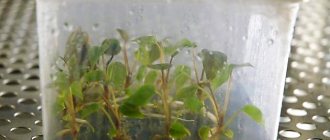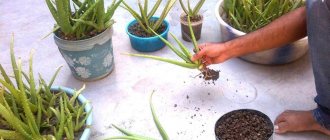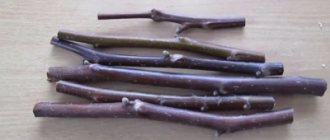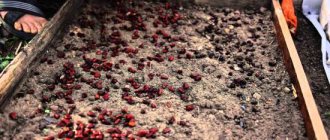Lemon grown in a pot is a popular houseplant. It has beautiful glossy leaves and long-lasting blooms with delicate, white or cream flowers with a pleasant aroma. During the fruiting period, the tree produces miniature, bright and tasty fruits.
You can grow a lemon from a fruit seed purchased at the supermarket. In this case, the first fruiting is expected no earlier than after 5 years. If you propagate the plant by cuttings, you can bring this event closer by 1-2 years. Read on to learn how to grow a lemon from a cutting and where to get good planting material.
Benefits of propagating lemon from cuttings
Propagation of indoor lemon by cuttings, in comparison with other methods, has advantages:
- Lemon obtained from the seed will be more active and stronger in terms of growth. But at the same time it will not retain the characteristics of the parent variety. But in cuttings this result is 100% guaranteed. This is important if you want to maintain varietal characteristics.
- My favorite part is the speed. With such propagation, the period for obtaining the first harvest is reduced. The ovary, depending on care and variety, will appear already 2-3 years after cutting. They missed the deadline, so to speak.
- Saves money. An already rooted cutting (and even more so a tree) cannot be compared to the price in garden stores and fairs. I watched it once and was shocked.
- No knowledge required. Everything is very simple.
Don't want to propagate citrus fruits from cuttings? Learn how to grow a lemon from a seed! I talked about this not long ago.
You can learn more about cuttings in the following video below:
Necessary rooting conditions
Lemon cuttings require careful preparation of the shoots themselves. But you need to know not only how to plant lemons at home, but also what recommendations should be followed, and what nuances need to be given more attention. Anyone can propagate lemons by cuttings, provided that an optimal microclimate is created in the room. Maintain a temperature range of 20–25 degrees if you want to successfully cut lemons.
Another important point is lighting. Planting a lemon using a cutting will bear fruit if there is a lot of light in the room. But you should not place a flowerpot with citrus plant shoots in the southern part of the house. The sun's rays are useless for now. Natural lighting should be diffused. The main emphasis is on artificial glow. Don't forget that to grow lemons from cuttings, it is important to maintain a high level of humidity in the room. In addition, regularly spray the bush with warm water.
Features of lemon root formation
For effective root formation, water should not stand in the pot. To achieve this result, lay a layer of drainage along the bottom. Now I’ll share how to improve the formation of the root system in cuttings:
- In the first 1-2 weeks, water the plant with a decoction of willow branches. To prepare, take 4-6 fresh medium-sized branches, fill them with hot water (2 l) and cook for 30 minutes. Strain and after cooling, start watering. Cheap and cheerful.
- Carry out regular watering with the addition of special agents that stimulate root formation. Also, take filtered or spring water.
- By 3 weeks, the roots will already appear. To check, pull the stem. If it doesn’t stretch out, it means it’s rooted. If you pulled it out, then, alas, the only thing left to do is throw it away.
And it’s even easier to observe the plant. A new leaf has appeared - congratulations, the citrus has taken root and will continue to grow. Below, for your convenience, I have collected root formation stimulators that I use myself.
| Name | Description |
| Kornevin | White powder. It is not diluted, but used in this form: cuts of cuttings are powdered with it. |
| Heteroauxin | Sold in tablet or powder form (I take the first option). It is first diluted with water (according to the instructions), and then the twig is soaked in the solution. |
| Cornerost | Potassium salt. The product is available in capsules. Divorced according to the same principle as the previous option. |
| Krezacin | Already prepared liquid. Advantages: simplicity and ease of use. |
The same products are used for other crops. For example, I use it for growing strawberries. As a result, the root develops quickly and grows actively.
Only healthy and strong shoots are subject to cuttings
Breeding time
Gardeners are inclined to believe that the time for cuttings is the beginning of spring: the sleep period ends and active sap flow through the plant begins. Another option is the end of summer, when the heat has already subsided and it is easier for lemon to organize conditions as close as possible to natural ones.
Author's note
Natalia Papanova
Blog author
Propagation can be carried out at other times if desired, the main thing is that the cuttings have time to take root before the start of the winter period.
Further care
By rooting a cutting of a homemade lemon, you will get a young, but not yet strong, tree. In the future, the intensity of its development and fruit formation will depend solely on you. That is why high-quality care for shrubs must be provided. While the plant is small, take your time with bright lighting. The tree gets used to it gradually, and this must be taken into account. It is very important to create an optimal microclimate for the citrus flower. The air temperature should not change sharply, as this will stress the plant.
Pay special attention to fertilizing. They are carried out from the very beginning of spring until mid-autumn. It is recommended to alternately add organic and mineral compounds to the substrate. This way the indoor tree will receive all the necessary elements for development. Some gardeners prefer to buy complex nutrient mixtures. They are useful, the main thing is to buy fertilizer intended specifically for citrus indoor flowers. Take care of rooted lemon cuttings and one day you will get a healthy plant that will not only decorate your home, but also bring you useful fruits.
Lemon propagation by cuttings
Lemon cuttings for propagation are a multi-layered procedure. Consider a few points that I discuss below. In this case, the shoot will take root and in a couple of years you will get a harvest. I also grow blueberries on the balcony using the same method. Two healthy bushes have already started to grow.
Have you tried propagating lemons by cuttings?
Not really
Choosing a cutting
Regardless of the method of reproduction, the choice of planting material is an important (I would even say the main) point. We picked up the wrong branch, and all our efforts went to waste. Seedlings must meet the following requirements:
- age – at least 1 year;
- length – 10-12 cm, thickness – 4-5 cm. Pay attention to this point: thick cuttings will take a long time to take root, and thin ones will not take root in a new place;
- There are a couple of leaves and buds on the branch.
The selected cutting should be woody. Thanks to this, the likelihood that it will take root increases.
Don't want to bother with such questions? Store cranberries at home, as well as other healthy berries.
Preparing the cuttings
Great, you've chosen the branch. But before you start preparing the cuttings, a cut is first made. Here the principle: “Tear it off and stick it in the ground” does not work. For pruning, choose a sharp utility knife or garden shears. Treat them with an antiseptic for disinfection so as not to introduce infection to the plant
. And then cut the branch at an angle. Preparation:
- Soak the cutting in a solution that stimulates root formation. I chose “Kornevin”. Soaking time is 8-10 hours.
- Then dip the cut end of the twig into the ash. This prevents rotting and other diseases.
- Remove the bottom leaf, leave the top one unchanged, and cut the rest to half (there should be 4-5 leaves on the cutting). Thanks to this, the shoot will be spent on the formation of roots.
Without trimming leaves, the plant takes longer to take root
Rooting cuttings
Everything is ready, now all that remains is to answer the question of how to root a lemon sprig. The procedure was carried out in the following stages:
- I prepared the soil for rooting (if you can call it that). In short, I took coarse river sand from the store.
- Conducted disinfection. To do this, I washed it 3-4 times (until the water became clear. Then I steamed it for 40 minutes and dried it. It’s a tedious task, of course, but it’s better to do it so that the sprout doesn’t get sick in the future.
- In medium-sized wooden boxes I laid a layer of drainage, then sand (12-15 cm).
- I stuck the cuttings into the ground (they should go 1-1.5 cm deep).
- Covered the top with a plastic bottle. Replaced with film, polycarbonate or glass container.
That's all, now we wait for the cuttings to take root.
For another simple rooting method, see the following video below:
Necessary rooting conditions
The cutting will not take root if it is stuck into the ground. Observe rooting conditions:
- Be aware of the temperature. The required indicator is from 20 to 25 degrees Celsius.
- Watch the lighting. Daylight hours for lemon cuttings are 12 hours. Better diffused sunlight. If it is not there, make artificial lighting.
- Provide high humidity - up to 95%. To do this, regularly spray the lemon and make sure that there is moisture in the greenhouse you created.
Author's note
Natalia Papanova
Blog author
Make sure that the shoot is not exposed to direct sunlight. Otherwise, burns will appear, and from them - diseases.
Caring for rooted cuttings
Caring for a rooted cutting is not difficult - this is the favorite part. For the first 2-3 weeks, keep the plant under a hood (to create a greenhouse effect). Every day, spray with clean water and ventilate for 15-20 minutes, eventually increasing this period of time by 5 minutes each time. After 1.5 months, feed with fertilizer for citrus fruits (I use Bon Forte).
Did you manage to root the cutting?
Not really
Selecting cuttings for planting
Before cutting a branch, you need to study what a lemon sprout looks like to carry out an important procedure:
- The plant from which the branch is cut must bear fruit for more than one year. The ideal age is 3-4 years.
- Suitable length of planting material is 10 cm, thickness – 5 mm. It is worth remembering that branches that are too thick take a very long time to form a root system, while thin branches quickly die before they have time to acquire roots.
- The presence of buds and leaves is required.
Lemon cuttings involve the use of lignified twigs. Such specimens take root the fastest.
Important! For cuttings, only absolutely healthy branches, full of strength and energy, are used.
How to plant a lemon cutting
If the cutting has taken root, it's time to start planting. There is nothing difficult in it, but in order to still achieve the desired result, study the instructions and rules of procedure.
It takes 2 to 2.5 months for a lemon to root. Then you can plant it
Preparing containers and soil
Take a clay container for planting. If necessary, it absorbs excess moisture, and if there is a deficiency, it gives it to the plant. Diameter – 9-10 cm.
The soil should contain the following components:
- coarse river sand;
- leaf soil;
- turf land;
- manure.
Mix all ingredients: 0.5 parts sand, 1 part other ingredients. If you don’t want to prepare the soil for planting yourself, buy ready-made soil called “Lemon” in the store. Suitable for other exotic plants, for example, I grow kiwi in it. Be sure to check it out!
Planting lemon cuttings
Planting the cuttings is carried out in the following sequence:
- Place a layer of drainage (2-3 cm), a layer of river sand (3-5 cm) and prepared soil in the pot. Moisten the soil.
- Take a lemon stalk from the nursery with a lump of earth.
- Make a hole in the ground large enough to accommodate a lump of roots formed on a lemon branch.
- Place inside and cover with soil. Place in a shaded place, gradually increase the amount of light.
How to plant a lemon shoot without roots
The branch is planted in a pot with ready-made soil and drainage. I rarely did this: there was less fuss, but the likelihood of rooting was reduced. In order for the shoot to grow, follow the rules:
- cover the branch with a dome and regularly moisten it with a spray bottle (2-3 times a day);
- ventilate once every 2-3 days;
- place in partial shade;
- water with a solution to stimulate root formation. “Krezatsin” will do.
How to grow a lemon from a twig
If you follow the rules mentioned above, then growing a lemon from a twig is not difficult. The main thing is to provide conditions for rooting, growth and development. Also, check the shoot regularly to prevent diseases and pests from appearing. And if they appear, start treatment without delaying this matter.
What kind of lemon is best to grow in an apartment?
There are many species of this exotic plant that are suitable for home cultivation, but you should choose low-growing varieties that produce a lot of yield. Among the best and most popular options are the following:
- "Meyer" . If you are interested in how to grow fruit-bearing lemon, then it is recommended to choose this variety for planting, which bears fruit early and in large quantities. The tree reaches a height of 1-1.5 m. Flowering is observed throughout the year. The fruits are not too sour, but they are juicy.
- "Novogruzinsky" . A vigorous tree that needs regular pruning and crown shaping. The fruits are oval and slightly elongated, and they are loved for their exquisite taste and powerful aroma. When grown, you can get a lot of fruits. The plant survives normally in dry air in winter.
- "Panderosa" . The variety is not demanding on growing conditions, which is why it has become popular. It is worth noting the presence of huge fruits; specimens weighing 1 kg were recorded. Their flesh is light green.
Caring for a lemon cutting planted in a pot
Now comes the part that will last until the very end - caring for the lemon tree (well, almost a tree). A combination of factors is taken into account here.
With proper care, the cuttings will quickly grow and develop
Lighting
Diffused lighting. Daylight hours are from 10 to 12 hours. A suitable place is near a window located on the southern part of the room. I have it there. Only in the summer do I move it to the back of the room. In the hot season there is enough light for lemon. Otherwise, the summer heat will burn it.
Author's note
Natalia Papanova
Blog author
Do not move the lemon from place to place frequently unless necessary. He bears it painfully.
Temperature
The required indicator is from 16 to 20 degrees Celsius. If the temperature drops below 14, the shoot will not only lag behind in growth, but will also die. So carefully monitor the temperature, avoiding hypothermia and sudden changes.
Humidity
For a cutting planted in a pot, the air humidity should no longer be as high as during rooting. Here the indicator varies in the range from 65% to 85%. For measurement purposes, use a special device - a hygrometer. Sold at any garden store. To achieve this indicator, regularly spray the lemon with water from a spray bottle and place containers filled with liquid nearby.
.
Watering
In spring and summer, watering is plentiful. It takes me 250-500 ml per copy (every day, less often every other day). In winter, the soil is moistened less: 2-3 times a week. Watch here as the soil dries out.
Make sure that the water does not stagnate in the pot. Otherwise, this leads to rotting of the roots.
Top dressing
Fertilizing was carried out immediately after planting the cuttings in the pot. Then I repeated it every 2 weeks for the entire period of intensive growth. I alternated organic fertilizers with inorganic ones. I used the following complexes:
- Superphosphate. A bush will require 30-40 g of product. To apply, place in the root part and water generously.
- Potassium sulfate. To fertilize limo, dissolve 20 g of the product in 10 liters of water. Then moisten the soil with the resulting liquid.
- Slurry. Here we make a solution according to the following proportion: 1 part manure to 2 parts water. They diluted it, mixed it, and then left it to infuse for 12 hours. Then apply it to the root part.
- “Hello.” To obtain ready-to-use fertilizer, dilute 15 g of dry matter in 10 liters of water. You can water the plant immediately after.
Loosening
To ensure that the roots are saturated with air and the water does not stagnate in the pot, loosen the soil regularly. I carry out 2-3 procedures per month. This is enough for lemon.
And if you do not want to grow fruit crops at home, you can choose another option. I recently told you how to store lingonberries at home, read for fun!)
Types of cuttings
Today, lemons reproduce in several ways. Some of them are quite simple and accessible even to beginners, others require certain skills in working with fruit trees.
Vaccination
To propagate in this way, shoots obtained from seeds are taken as a rootstock. The scion is a cultivated variety of lemon, adapted for growing at home. It is acceptable to use other types of citrus fruits for these purposes, with the exception of tangerine.
The grafting is done when the plant has active movement of sap, that is, in spring or summer. It can be made into a split or into a butt. When performing work, you must use thoroughly disinfected tools, otherwise it is easy to infect the plant and it may die.
Budding
The budding method involves inserting a bud from a fruiting tree into a T-shaped incision made in the bark of the rootstock. It is recommended to use 2-3 seedlings for these purposes, the thickness of which has reached the size of a pencil. The place for vaccination is chosen at a distance of 5-10 cm from ground level.
After budding, the area is carefully bandaged. If after 2-3 weeks the petioles fall off, then the procedure is considered successful. If they dry out, then the grafting was unsuccessful. After 30 days, the upper part of the rootstock is cut off, leaving 10 cm above the grafting site. After the eye has germinated, a cut is made directly above it.
Rooting
When rooted by cuttings, an exact copy of the parent plant is obtained. On average, the flowering period of a bush can be expected in the 3-4th year. Modern growth stimulants greatly increase the chances of survival of cuttings, so this method of lemon propagation remains one of the most popular.
Air layering
The advantage of propagation by layering is obtaining almost 100% results. The disadvantage is the cumbersome nature of the method and the time required to carry out the work. For propagation, a pot with nutritious soil is placed nearby. Several cuts are made in the branch of the parent tree, tilted and pinned, and then covered with earth. In places of damage, root segments will begin to form; after 2 months, the clone can be cut off.
See also
How and when to transplant a lemon into another pot at homeRead
Chinese air layering involves the formation of a cut on a branch in the spring, followed by covering the damaged area with moss; it is wrapped in film, periodically moistening the sphagnum. It provides the plant with moisture and a bactericidal effect, as a result of which roots form at the cut site. When they are sufficiently formed, the cuttings are separated from the parent tree and planted in a separate container.
How else can you propagate indoor lemon?
Cuttings are not the only way to propagate a lemon tree. Depending on the conditions and capabilities, other options are used.
Division by rhizome
The method is suitable if the tree is strong, large with an overgrown rhizome. It is more convenient and easier to do this at the time of transplanting the plant (you still have to take it out of the pot).
To divide for further growing, first clear the bottom of the lemon from the soil. Then use a sharp knife to cut the rhizome into pieces so that each piece contains leaves and roots. Sprinkle the cuts with crushed coal and plant them in different pots.
If the rhizome is weak, do not propagate, otherwise the tree will die
Seeds
Propagation by seeds is the longest growing method. Here it is important to select planting material (lemon seeds) and provide conditions for germination.
The process goes like this:
- Seeds (that is, seeds) are collected from the lemon.
- Soak in water for 2 to 3 days.
- Next, they are placed in cells with soil to a depth of 1.5-2 cm. They are sprinkled with earth, moistened with water from a spray bottle and set aside. That's it, now we wait for them to sprout.
By layering
Reproduction by layering brings results: in a couple of months you will get a strong shoot with a good root system. After transplantation, the lemon immediately grows and develops.
To carry it out, cut a branch 15-20 cm long from the lemon. Tear off the leaves on the lower part, which will sink into the water. Leave the top of your head. Place in a container with clean water until roots form. As soon as you see their presence, you can immediately stick a twig into the ground. She will grow quickly.
You can see how the process of such reproduction occurs in a different way in the following video below:
Soil for growing lemon
What kind of soil is needed to grow lemon? As with various plants, you can simply purchase soil or prepare it yourself. If everything is clear with the purchase - we are purchasing soil for indoor plants, then for independent preparation you will need the following composition, of course, not the only one that can be used for this purpose:
- garden soil (2 tbsp), river sand (1 tbsp), humus (3 tbsp), ash (1 tbsp). All components are mixed, a certain amount of water is added.
For good fruiting, they resort to periodic feeding. Their volume must be increased in the spring and reduced to a minimum in winter. It is best to use liquid complex fertilizers. If dry fertilizers are used, they are diluted with water. That’s basically all I wanted to tell you at the moment about growing lemons at home.
I also suggest you watch a video on the topic discussed above.
My courtyard
.
Breeders have developed several methods for grafting citrus trees, but propagating lemons by cuttings is easier and more effective.
Propagating lemons from cuttings is simple and effective.
To grow a lemon at home from a cutting, you need to learn how to take a lemon cutting correctly and without harm, and how to care for the lemon.
I will highlight the main thing
- Do not take weak branches for cuttings: they will either die or get sick.
- Lemon trees should not be propagated during fruiting or flowering periods. Then he already loses a lot of energy.
- Monitor the humidity for rooting of the cuttings. The required figure is 95%.
- Do not place the shoots (and even mature trees) in direct sunlight. Otherwise, the lemon leaves may get burned.
I hope now you understand how to cut lemons in an apartment. If you understand the process, there is nothing complicated about it. Over time, you will get used to it and will do everything automatically. The main thing is just to start and get a taste for it. And then everything will go like clockwork.











